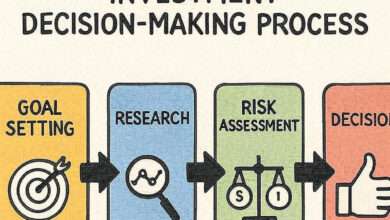latest post
-

Personalized Investment Plan: Tailor Your Portfolio
Building a Personalized Investment Plan Description Step-by-step guidance on creating a portfolio that matches your goals time frame and risk tolerance Featured Image A person reviewing a digital fina # Building a Personalized Investment Plan In the world of personal finance, creating an investment plan tailored to your specific needs is crucial. Whether you’re saving for retirement, a house, or just looking to grow your wealth, a personalized investment plan can help you reach your goals. This guide will take you through the step-by-step process of building a portfolio that matches your goals, time frame, and risk tolerance. Understanding Your Financial Goals Before diving into investments, it’s essential to define what you’re aiming for. Your financial goals will dictate the structure of your investment plan. Are you saving for a short-term goal like a vacation, or is it a long-term goal such as retirement? Defining these will help shape your strategy. Short-Term vs. Long-Term Goals Short-term goals typically have a time frame of less than three years. For these, you might consider safer investments like high-yield savings accounts or bonds. Long-term goals, on the other hand, could involve higher risk investments such as stocks or real estate, which generally offer higher returns over time. Assessing Your Risk Tolerance Your risk tolerance is your ability and willingness to lose some or all of your original investment in exchange for greater potential returns. It’s crucial to understand this before investing, as it will influence the types of assets you choose. Risk Tolerance Levels Conservative: Preferably low-risk investments, even if it means lower returns. Moderate: Willing to take on some risk for a chance of better returns. Aggressive: Comfortable with high risk for the possibility of high returns. Time Horizon Your investment time horizon is the period you expect to hold your investments before needing the money. The longer the time horizon, the more risk you can typically afford to take, as you’ll have more time to recover from potential losses. Matching Time Horizon with Investment Choices…
Read More » -

Compound Interest: Grow Wealth Exponentially
The Role of Compound Interest Description See how reinvesting earnings helps your money grow exponentially over time Featured Image A small plant growing from a pile of coins symbolizing steady compou When it comes to building wealth, understanding the concept of compound interest can be a game changer. Compound interest is a powerful financial tool that can significantly increase your savings and investments over time. By reinvesting your earnings, you allow your money to grow exponentially, turning a modest investment into a substantial sum over the years. In this article, we will explore the role of compound interest, how it works, and how you can use it to your advantage. We will also provide insights into the compound interest formula and how to use a compound interest calculator to plan your financial future. What is Compound Interest? Compound interest is the interest on a loan or deposit that is calculated based on both the initial principal and the accumulated interest from previous periods. Unlike simple interest, where you earn interest only on your initial deposit, compound interest allows you to earn interest on your interest, leading to a snowball effect of growth. How Does Compound Interest Work? To better understand how compound interest works, let’s consider an example. Suppose you deposit $1,000 in a savings account with an annual interest rate of 5%, compounded annually. At the end of the first year, you would earn $50 in interest, bringing your total to $1,050. In the second year, you would earn interest on the new total of $1,050, rather than just the initial $1,000. This process continues, with each period’s interest being calculated on the new total, leading to exponential growth over time. The Compound Interest Formula To calculate compound interest, you can use the following formula: [ A = P \left(1 + \frac{r}{n}\right)^{nt} ] Where: ( A ) is the amount of money accumulated after n years, including interest. ( P ) is the principal amount (the initial sum of money). ( r ) is the annual interest rate (in decimal form). ( n ) is the number of times that interest is compounded per year. ( t ) is the number of years the money is invested or borrowed for. By using this formula, you can estimate how much your initial investment will grow over a specific period, considering different compounding frequencies.…
Read More » -

Master Emotional Discipline in Investing: Achieve Success
Emotional Discipline in Investing Description Understand why managing your emotions is as crucial as market knowledge for financial success Featured Image A serene investor meditating amid fluctuating # Emotional Discipline in Investing Investing isn’t just about knowing when to buy or sell; it’s also about having the emotional discipline to…
Read More » -

Evaluating Investment Opportunities: Key Metrics Guide
Key Metrics for Evaluating Investment Opportunities Evaluating investment opportunities can be daunting, especially with the multitude of options available today. To navigate this complex landscape, investors rely on key metrics to assess risk, understand market dynamics, and make informed decisions. In this article, we’ll explore these essential metrics and how they can guide your investment strategy. Risk assessment is a fundamental step in evaluating any investment. It involves analyzing potential risks that could affect the return on investment (ROI). Understanding these risks helps investors gauge whether an opportunity aligns with their financial goals and risk tolerance. Types of Investment Risks Market Risk: This is the risk of losses due to changes in market conditions. It can be influenced by economic shifts, political events, or changes in investor sentiment. Credit Risk: This refers to the possibility that a borrower might default on a loan or bond. It’s crucial for investments in fixed-income securities. Liquidity Risk: This risk arises when an asset cannot be sold quickly without a significant price reduction. It’s vital to consider this when investing in less liquid markets. Operational Risk: These are risks stemming from internal failures, such as management errors or technical glitches. They can impact the overall performance of an investment. By understanding these risks, investors can better evaluate the potential downsides of an investment opportunity. Evaluating Market Potential Market analysis is another critical component of evaluating investment opportunities. It involves examining the market environment to predict future trends and determine the viability of an investment. Key Market Analysis Metrics Market Size and Growth: Understanding the total available market (TAM) and its growth rate can indicate the potential for expansion and profitability. Competitive Landscape: Analyzing competitors helps identify market leaders and potential threats. Consider factors like market share, product differentiation, and customer loyalty. Regulatory Environment: Changes in regulations can significantly impact market dynamics. Staying informed about current and upcoming regulations ensures that investments remain compliant and viable. Economic Indicators: Metrics such as GDP growth, inflation rates, and employment levels provide insights into the broader economic context that can affect market conditions. By evaluating these metrics, investors gain a comprehensive view of the market’s potential and challenges. Financial Performance Metrics Financial performance metrics are crucial for assessing the health and profitability of an investment. These metrics provide a quantitative basis for comparing different investment opportunities. Essential Financial Metrics…
Read More » -

Long-Term vs Short-Term Investing: Key Strategies
Understanding Long-Term and Short-Term Investing Strategies Investing can seem like a daunting task, especially if you’re new to it. However, understanding the difference between long-term and short-term investing strategies can help you make informed decisions and improve your financial planning. In this article, we will explore the benefits and risks associated with both types of investing, helping you determine which strategy might be best for you. Long-term investing is all about patience and the potential for substantial growth over time. This approach involves holding…
Read More » -

Diversification in Investments: Reduce Risk & Boost Stability
Discover how spreading investments across different asset classes reduces risk and boosts long-term stability In the world of investing, the concept of diversification stands as a fundamental principle for anyone looking to build a robust financial portfolio. At its core, diversification involves spreading your investments across various asset classes and industries to minimize risk and maximize potential returns. This strategy not only helps in managing risk but also enhances the stability of your investments over the long haul. In this article, we will…
Read More » -

Mastering Risk and Return: Smart Investment Strategies
Understanding Risk and Return Description Learn how to balance potential rewards with acceptable risk levels when choosing investments # Understanding Risk and Return: Learn How to Balance Potential Rewards with Acceptable Risk Levels When Choosing Investments Investing can be an exciting journey filled with the potential for growth and wealth accumulation. However, it also comes with its own set of challenges, primarily revolving around the concepts of risk and return. Understanding these concepts is crucial for making informed investment decisions. In this article, we’ll explore what risk and return mean, how they relate to each other, and how you can balance them to achieve your investment goals. Risk, in the context of investing, refers to the possibility of losing some or all of your original investment. It is the uncertainty associated with the returns you expect to earn. Different investments come with varying levels of risk, and it’s important to understand these risks before committing your money. Types of Investment Risks Market Risk: This is the risk of losses due to changes in the market prices. Factors such as economic recessions, political turmoil, or changes in interest rates can affect the entire market. Credit Risk: This occurs when a borrower fails to repay a loan or meet contractual obligations. It primarily affects bonds and other fixed-income investments. Liquidity Risk: This is the risk of not being able to sell your investment quickly enough to prevent a loss. Investments like real estate or certain stocks with low trading volumes can be difficult to sell. Inflation Risk: The risk that inflation will erode the purchasing power of your money, particularly if your investments do not yield returns above the inflation rate. Interest Rate Risk: Changes in interest rates can affect the value of investments, particularly bonds. When rates rise, bond prices generally fall, and vice versa. What is Return in Investing? Return is the gain or loss generated by an investment over a particular period. It is usually expressed as a percentage of the initial investment. Returns can come in the form of interest, dividends, or appreciation in the value of the investment. Calculating Return Understanding how to calculate return is essential. Here’s a simple formula to determine your investment return: [ \text{Return} = \left( \frac{\text{Current Value} – \text{Initial Investment}}{\text{Initial Investment}} \right) \times 100 ] For example, if you invested $1,000 in a stock that is now worth $1,100, your return would be: [ \left( \frac{1100 – 1000}{1000} \right) \times 100 = 10% ] The Relationship Between Risk and Return Generally, the relationship between risk and return is direct; the higher the potential return, the higher the risk involved. Investors are often required to decide how much risk they are willing to take on to achieve their desired level of return. Risk-Return Tradeoff…
Read More » -

Top Benefits of Educational Toys for Babies
Benefits of Educational Toys for Babies When it comes to the development of your baby, every parent wants to give their child the best start in life. Educational toys can play a significant role in nurturing a child’s growth by promoting cognitive, physical, and emotional development. This article delves into the myriad benefits of educational toys for babies and how they can help foster a love for learning from an early age. Educational toys are designed to stimulate a child’s mind and help them learn essential skills. Unlike regular toys, these are specifically crafted to encourage learning and development in infants. They are not only fun but also facilitate learning in an engaging way. Here’s why incorporating educational toys into your baby’s playtime is crucial. Enhancing Cognitive Development From as early as three months, babies start to explore the world around them. Educational toys for infants aged 3 to 6 months, such as colorful rattles or textured balls, help stimulate their senses. These toys enhance cognitive development by: Encouraging visual and auditory skills as babies track objects with their eyes and respond to sounds. Developing problem-solving skills through interactive play. Promoting memory retention by introducing patterns, shapes, and colors. Promoting Physical Development As babies grow, their physical abilities develop rapidly. Toys for 5-month-olds and beyond, like soft blocks or push-and-pull toys, are excellent for improving motor skills. These toys support physical development by: Strengthening muscles through activities like reaching, grabbing, and crawling. Enhancing hand-eye coordination as babies manipulate objects. Encouraging mobility as they explore their environment. The Role of Educational Toys in Emotional and Social Growth Building Emotional Intelligence Educational toys also play a pivotal role in fostering emotional intelligence. By engaging with toys designed for infants aged 6 to 12 months, babies can: Learn to express emotions through play, such as joy or frustration. Develop empathy by interacting with dolls or plush toys that mimic real-life scenarios. Build self-esteem as they achieve small milestones with toys designed for their age group. Encouraging Social Interaction…
Read More » -

Dow Jones Market Drop Explained: Key Insights
Market Analysis: Dow’s Drop Explained Today Understanding the fluctuations in the stock market can be perplexing, especially when significant indices like the Dow Jones Industrial Average take a dive. Today, we’ll delve into why the Dow dropped, the contributing factors, and what it means for investors. by Arturo Añez (https://unsplash.com/@americanaez225) The Dow Jones: A Quick Overview Before we explore today’s market movement, let’s understand what the Dow Jones Industrial Average (DJIA) represents. Established in 1896, the DJIA is a stock market index that measures the stock performance of 30 prominent companies listed on stock exchanges in the United States. It’s one of the most-watched indices in the world and often used as a barometer for the overall health of the U.S. economy. Why Did the Dow Drop Today? Several factors can influence the stock market, and the Dow Jones is no exception. Let’s break down the key reasons for today’s decline. Economic Indicators Economic indicators are statistics that provide insights into the economic performance of a country. They can include employment rates, GDP growth, and consumer spending. If new data reveals a weaker-than-expected economy, investors might sell stocks, leading to a market drop. Today, a disappointing jobs report showed fewer job gains than anticipated. Such news can stir investor concerns about economic growth and potential downturns, prompting them to pull back from stocks. Interest Rates and Central Bank Policies Interest rates set by central banks like the Federal Reserve have a substantial impact on stock markets. Higher interest rates can make borrowing more expensive for companies, potentially slowing expansion and profit growth. Conversely, lower rates can encourage investment but may signal economic troubles. Today, speculation about future rate hikes by the Federal Reserve spooked investors. Concerns that the central bank might increase rates to control inflation led to uncertainty and a sell-off. Global Events Events beyond the U.S. borders can also weigh on the Dow Jones. Political instability, trade tensions, or economic crises in other countries can cause ripples in U.S. markets. Recent geopolitical tensions, particularly in Eastern Europe, have heightened fears of international conflicts. The potential for disruptions in global trade and energy markets has made investors wary, contributing to today’s market downturn. Stock Market Volatility: A Normal Phenomenon It’s important to remember that stock market fluctuations are normal. The market reacts to news, events, and investor sentiment, which can cause short-term volatility. However, long-term trends are usually more stable, and experienced investors often view dips as buying opportunities. Investor Sentiment Investor sentiment refers to the overall attitude of investors toward a particular market or security. It’s driven by emotions and perceptions rather than concrete fundamentals. When sentiment turns negative, it can lead to a market sell-off, as seen today.…
Read More » -

Ecommerce Storefront Design: Avoid These Mistakes
Common Mistakes in Ecommerce Storefront Design # Common Mistakes in Ecommerce Storefront Design In the rapidly evolving world of ecommerce, a well-designed storefront is crucial for attracting and retaining customers. However, many businesses make common mistakes in their ecommerce storefront design that can hinder their success. Understanding what these mistakes are and how to avoid them can be the difference between a thriving online store and one that struggles to stay afloat. Understanding Ecommerce Before diving into the common pitfalls, it’s important to grasp the basics of ecommerce. So, what does ecommerce mean? Simply put, ecommerce, or electronic commerce, refers to the buying and selling of goods and services over the internet. It involves electronic commerce transactions and the role of ecommerce in bridging the gap between businesses and consumers digitally. What is an Ecommerce Storefront? An ecommerce storefront is the digital equivalent of a brick-and-mortar store. It’s the online platform where businesses display their products or services and where customers make purchases. Understanding how ecommerce works step by step is essential for designing an effective storefront that meets customer needs and enhances the shopping experience. Common Design Mistakes and How to Avoid Them 1. Poor Navigation One of the most frequent mistakes in ecommerce storefront design is poor navigation. When customers visit your site, they should be able to find what they’re looking for quickly and easily. Complicated menus or unclear categories can frustrate users and drive them away. Solution: Implement a clean, intuitive navigation bar with clear categories and subcategories. Use breadcrumb trails to help customers keep track of their location within your site. This improves the overall user experience and encourages visitors to explore more products. 2. Lack of Mobile Optimization In today’s mobile-driven world, failing to optimize your ecommerce site for mobile devices is a critical error. With a significant portion of ecommerce transactions occurring on smartphones and tablets, a non-responsive design can lead to lost sales. Solution: Ensure your site is mobile-friendly by using responsive design techniques. This means your site should automatically adjust its layout and functionality based on the device being used, providing a seamless experience for all users. 3. Slow Loading Times Customers expect fast loading times when shopping online. If your site takes too long to load, potential customers may abandon their carts in favor of a competitor’s site. Solution: Optimize your site’s performance by compressing images, minimizing the use of heavy scripts, and leveraging browser caching. Regularly testing your site’s speed can help identify areas for improvement. 4. Inadequate Product Descriptions Product descriptions are a vital component of your ecommerce storefront. Insufficient or unclear descriptions can leave customers with unanswered questions, leading to hesitation in making a purchase.…
Read More » -

Top Shipping Software for E-commerce Success
Best Shipping Programs for E-commerce Success In the dynamic world of e-commerce, the efficiency of your shipping process can make or break your business. Selecting the best shipping programs is crucial for ensuring timely deliveries, enhancing customer satisfaction, and maintaining competitive advantage. This guide delves into the top shipping solutions that cater specifically to e-commerce businesses, helping you streamline operations and boost your bottom line. Before diving into specific programs, let’s understand what e-commerce shipping solutions entail. These programs integrate with your online…
Read More » -

Healthy Living: Essential Health Tips
Essential Tips for Maintaining Good Health # Essential Tips for Maintaining Good Health Maintaining good health is more than just eating right and exercising. It involves a balanced approach that includes mental well-being, regular physical activity, and mindful eating habits. Let’s explore some essential tips to help you achieve and maintain optimal health. Mental health is just as important as physical health. A healthy mind can lead to a healthier…
Read More » -

Machine Learning Basics: Unlocking AI Potential
Understanding the Basics of Machine Learning # Understanding the Basics of Machine Learning Machine learning is transforming the way we interact with technology every day. From personalized recommendations to voice assistants, it’s all around us. But what exactly is machine learning, and how does it work? In this article, we’ll break down the basics of machine learning, explore its relationship with data science, and delve into its applications in data mining. At its core, machine learning is a method of data analysis that automates analytical model building. It…
Read More » -

Top Free Educative Online Games: Boost Learning & Fun
about educative online game In today’s digital age, the fusion of education and technology has revolutionized the way we learn. Among the most impactful innovations are educative online games. These games are not just about fun and entertainment; they offer a unique blend of learning and play that can significantly enhance educational outcomes. In this article, we will explore the world of educational games online, their benefits, and how they can be effectively integrated into learning environments. Educative online games are digital games specifically designed to teach and reinforce learning concepts. Unlike traditional educational tools,…
Read More » -

Top 10 Math Games for Kids: Fun & Educational
Top 10 Math Games for Kids Math can be a challenging subject for many kids. But what if learning math could be fun and engaging? Math games offer a unique way to make math enjoyable. They combine learning with play, capturing kids’ attention. These games are not just fun; they are educational too. They help improve problem-solving skills and critical thinking. Many math games are available online for free, making them accessible to everyone. From classic games to new interactive apps, there’s something for every child. In this article, we will explore the top 10 math games for kids. These games are designed to make math learning an exciting adventure. Why Math Games Matter for Kids Math games play a vital role in education. They transform abstract concepts into concrete experiences, making math less intimidating. Engaging with fun math games allows kids to explore math at their own pace. These games cater to various learning styles. Whether through visuals, hands-on activities, or interactive challenges, they accommodate diverse needs. Here are some key benefits: Improves problem-solving skills Enhances critical thinking Boosts confidence in math abilities Additionally, math games can be played anywhere. Whether in classrooms, homes, or online, they provide flexible learning options. Kids can even explore cool unblocked math games in school settings. How to Choose the Best Math Games Choosing the right math game can be daunting with so many options. Start by identifying your child’s learning needs and preferences. Consider games that align with their current skill level and interests. Look for games with clear instructions and engaging graphics. Here are some tips for choosing the best math games: Check for age-appropriate content Select games with progressive difficulty Prefer games with positive reviews and ratings…
Read More »